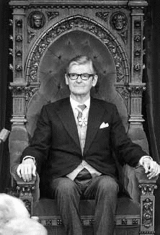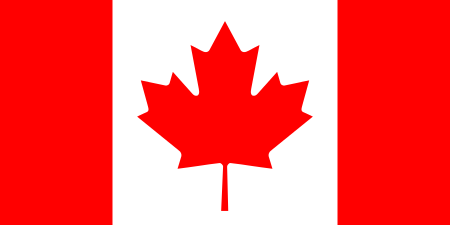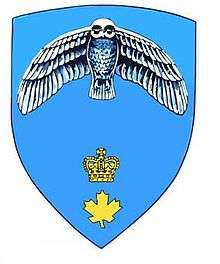Jules Léger
| The Right Honourable Jules Léger PC CC OMM CD | |
|---|---|
 | |
| 21st Governor General of Canada | |
|
In office January 14, 1974 – January 22, 1979 | |
| Monarch | Elizabeth II |
| Prime Minister | Pierre Trudeau |
| Preceded by | Roland Michener |
| Succeeded by | Edward Schreyer |
| More... | |
| Personal details | |
| Born |
April 4, 1913 Saint-Anicet, Quebec |
| Died |
November 22, 1980 (aged 67) Ottawa, Ontario |
| Spouse(s) | Gabrielle Léger |
| Profession | Diplomat |
Jules Léger PC CC CMM CD (April 4, 1913 – November 22, 1980) was a Canadian diplomat and statesman who served as Governor General of Canada, the 21st since Canadian Confederation.
Léger was born and educated in Quebec and France prior to starting a career in the Canadian Department of External Affairs, and eventually served as ambassador to a number of countries. He was in 1973 appointed as governor general by Queen Elizabeth II, on the recommendation of Prime Minister of Canada Pierre Trudeau, to replace Roland Michener as viceroy, and he occupied the post until succeeded by Edward Schreyer in 1979. As the Queen's representative, Léger was credited for modernising the office and fostering Canadian unity.
On June 1, 1979, Léger was sworn into the Queen's Privy Council for Canada,[1] giving him the accordant style of The Honourable. However, as a former Governor General of Canada, Léger was entitled to be styled for life with the superior form of The Right Honourable. He died on November 22, 1980.
Youth and career
Born in Saint-Anicet, Quebec, to Ernest and Alda (née Beauvais), Léger, along with his brother (and future cardinal), Paul-Émile, was raised in a devoutly religious family. After completing high school, Léger went on to the Collège de Valleyfield and then the Université de Montréal, where he completed a law degree. Léger subsequently enrolled at the Sorbonne in Paris, from which he was awarded a doctorate in 1938, the same year that, on August 13, he married Gabrielle Carmel, whom he'd met at the University of Paris. The couple together had two daughters, Francine and Helene.
When Léger returned to Canada at the end of 1938, he was hired as an associate editor of Le Droit in Ottawa, but remained there for only one year before he went on to become a professor of diplomatic history at the University of Ottawa until 1942. Simultaneously, Léger joined in 1940 the Department of External Affairs, and in just over 13 years received his first overseas diplomatic posting as Canada's ambassador to Mexico. After his retirement from that office on August 1, 1954,[2] he returned to Ottawa to act as under-secretary of state for external affairs, until, on September 25, 1958, he was commissioned as ambassador and permanent representative to the North Atlantic Council, occupying that post until 5 July 1962,[3] as well as the Canadian representative to the Organisation for European Economic Cooperation in Paris. Then, from 1962 to 1964, Léger held the commission of ambassador to Italy,[4] and, from 1964 to 1968 was the ambassador to France.[5] It was during this time, in July 1967, that French president Charles de Gaulle visited Canada to attend Expo 67, and in Montreal gave his Vive le Québec libre speech. This event caused a diplomatic chill for many years between Canada and France; however, Léger attracted admiration for his subsequent sensitive handling of de Gaulle's policy towards Quebec.[6]
By 1968, Léger had returned to Canada's capital and was appointed as under-secretary of state, providing the administrative basis for Prime Minister Lester B. Pearson's foreign policy, and the policies on bilingualism and multiculturalism developed by the Cabinet chaired by Pearson's successor, Pierre Trudeau.[6] Léger left that position in 1972, and briefly served as ambassador to Belgium and Luxembourg between March 1973 and January 1974.[7][8]
Governor General of Canada
It was on October 5, 1973 that Queen Elizabeth II had, by commission under the royal sign-manual and Great Seal of Canada, appointed Pierre Trudeau's choice of Léger to succeed Roland Michener as the Queen's representative. He was subsequently sworn-in during a ceremony in the Senate chamber on January 14, of the following year.[9]
Only six months later, just prior to a ceremony wherein he was to receive an honorary degree from the Université de Sherbrooke, Léger suffered a stroke, leaving him with impeded speech and a paralysed right arm. Though he returned to his viceregal duties not long after, presiding over an Order of Canada investiture in December 1974, his wife assisted him on many occasions, even reading parts of the Speech from the Throne in 1976 and 1978. Still, the Légers travelled across the country, encouraging Canadian unity at a time fraught with Quebec sovereignty disputes and perceived alienation by other regions,[10] as well promoting the fine arts and artistic endeavours, aided at such by their friendships with painters such as Jean Paul Lemieux, Alfred Pellan, and Jean Dallaire.[10] In 1978 Léger established the Jules Léger Prize for New Chamber Music. He also established an award for heritage conservation and the Jules Léger Scholarship to promote academic excellence in bilingual programs at the University of Regina. Léger was credited with greatly modernising the Office of the Governor General, having, among other things, eschewed the traditional court dress of the Windsor uniform in favour of morning dress at state functions, though he was also negatively criticised for the same, as well as for asking that decorations, particularly those from the Second World War, not be worn at certain state events.[11] He was further critiqued for remaining in such an important office despite his incapacitation.[11] Still, he remained focused on the person and institution he represented, and was known to write to the Queen on a monthly basis.[12] His official portrait was a first for including the viceregal consort, done to recognise Gabrielle's contributions to her husband's service.[10]
Post viceregal life
After leaving Rideau Hall, the Légers continued to live in Ottawa. Léger died on November 22, 1980, and was survived by his wife and daughter.
Titles, styles, honours, and arms
Titles
| Viceregal styles of Jules Léger (1974–1979) | |
|---|---|
 | |
| Reference style |
His Excellency the Right Honourable Son Excellence le très honorable |
| Spoken style |
Your Excellency Votre Excellence |
| Alternative style |
Sir Monsieur |
- April 4, 1913 – October 14, 1953: Mr Jules Léger
- October 14, 1953 – 8 July 1954: His Excellency Mr Jules Léger, Her Majesty's Ambassador Extraordinary and Plenipotentiary of Canada to Mexico
- 8 July 1954 – 28 May 1962: Mr Jules Léger
- 28 May 1962 – February 20, 1964: His Excellency Mr Jules Léger, Her Majesty's Ambassador Extraordinary and Plenipotentiary of Canada to Italy
- February 20, 1964 – April 17, 1964: His Excellency Mr Jules Léger, Her Majesty's Ambassador Extraordinary and Plenipotentiary of Canada to Italy and France
- April 17, 1964 – October 31, 1968: His Excellency Mr Jules Léger, Her Majesty's Ambassador Extraordinary and Plenipotentiary of Canada to France
- October 31, 1968 – March 1, 1973: Mr Jules Léger
- March 1, 1973 – January 8, 1974: His Excellency Mr Jules Léger, Her Majesty's Ambassador Extraordinary and Plenipotentiary of Canada to Belgium and Luxembourg
- January 8, 1974 – January 14, 1974: Mr Jules Léger
- January 14, 1974 – January 22, 1979: His Excellency the Right Honourable Jules Léger, Governor General and Commander-in-Chief in and over Canada
- January 22, 1979 – November 22, 1980: The Right Honourable Jules Léger
Honours
| Ribbon bars of Jules Léger | |||
|---|---|---|---|
- Appointments
-
 June 19, 1973 – January 14, 1974: Companion of the Order of Canada (CC)[13]
June 19, 1973 – January 14, 1974: Companion of the Order of Canada (CC)[13]
- January 14, 1974 – January 22, 1979: Chancellor and Principal Companion of the Order of Canada (CC)
- January 22, 1979 – November 22, 1980: Companion of the Order of Canada (CC)
-
 January 14, 1974 – January 22, 1979: Chancellor and Commander of the Order of Military Merit (CMM)[14]
January 14, 1974 – January 22, 1979: Chancellor and Commander of the Order of Military Merit (CMM)[14]
- January 22, 1979 – November 22, 1980: Commander of the Order of Military Merit (CMM)
-
 January 14, 1974 – January 22, 1979: Knight of Justice, Prior, and Chief Officer in Canada of the Most Venerable Order of the Hospital of Saint John of Jerusalem (KStJ)[15]
January 14, 1974 – January 22, 1979: Knight of Justice, Prior, and Chief Officer in Canada of the Most Venerable Order of the Hospital of Saint John of Jerusalem (KStJ)[15]
- January 22, 1979 – November 22, 1980: Knight of Justice of the Most Venerable Order of the Hospital of Saint John of Jerusalem (KStJ)
-
 January 14, 1974 – January 22, 1979: Chief Scout of Canada
January 14, 1974 – January 22, 1979: Chief Scout of Canada -
 1974 – November 22, 1980: Honorary Member of the Royal Military College of Canada Club
1974 – November 22, 1980: Honorary Member of the Royal Military College of Canada Club -
 June 1, 1979 – November 22, 1980: Member of the Queen's Privy Council for Canada (PC)
June 1, 1979 – November 22, 1980: Member of the Queen's Privy Council for Canada (PC)
- Medals
-
 January 14, 1974: Canadian Forces Decoration (CD)
January 14, 1974: Canadian Forces Decoration (CD) -
 1977: Queen Elizabeth II Silver Jubilee Medal
1977: Queen Elizabeth II Silver Jubilee Medal
Honorary military appointments
-
 January 14, 1974 – January 22, 1979: Colonel of the Regiment of the Governor General's Horse Guards
January 14, 1974 – January 22, 1979: Colonel of the Regiment of the Governor General's Horse Guards -
 January 14, 1974 – January 22, 1979: Colonel of the Regiment of the Governor General's Foot Guards
January 14, 1974 – January 22, 1979: Colonel of the Regiment of the Governor General's Foot Guards -
 January 14, 1974 – January 22, 1979: Colonel of the Regiment of the Canadian Grenadier Guards
January 14, 1974 – January 22, 1979: Colonel of the Regiment of the Canadian Grenadier Guards
Honorary degrees
-
 31 March 1974: University of British Columbia, Doctor of Laws (LLD)[16]
31 March 1974: University of British Columbia, Doctor of Laws (LLD)[16] -
 8 June 1974: Université de Sherbrooke, Doctor of the University (DUniv)[17]
8 June 1974: Université de Sherbrooke, Doctor of the University (DUniv)[17] -
 7 February 1976: Royal Military College of Canada, Doctor of Laws (LLD) [18]
7 February 1976: Royal Military College of Canada, Doctor of Laws (LLD) [18] -
 : University of Ottawa, Doctor of Laws (LLD)
: University of Ottawa, Doctor of Laws (LLD)
Honorific eponyms
- Awards
-
 Canada: Jules and Gabrielle Léger Fellowship
Canada: Jules and Gabrielle Léger Fellowship -
 Saskatchewan: Jules Léger Scholarship, University of Regina, Regina
Saskatchewan: Jules Léger Scholarship, University of Regina, Regina
Arms
 |
|
See also
References
- ↑ Privy Council Office (June 1, 2001). "Information Resources > Historical Chronological List Since 1867 of Members of the Queen's Privy Council for Canada > 1971–1980". Queen's Printer for Canada. Retrieved March 10, 2009.
- ↑ Department of Foreign Affairs and International Trade. "About the Department > Canadian Heads of Posts Abroad from 1880 > Italy". Queen's Printer for Canada. Retrieved March 10, 2009.
- ↑ Department of Foreign Affairs and International Trade. "About the Department > Canadian Heads of Posts Abroad from 1880 > North Atlantic Council". Queen's Printer for Canada. Retrieved March 10, 2009.
- ↑ Department of Foreign Affairs and International Trade. "About the Department > Canadian Heads of Posts Abroad from 1880 > Italy". Queen's Printer for Canada. Retrieved March 10, 2009.
- ↑ Department of Foreign Affairs and International Trade. "About the Department > Canadian Heads of Posts Abroad from 1880 > France". Queen's Printer for Canada. Retrieved March 10, 2009.
- 1 2 "Nations > Canada > Governors-General > Léger, Jules". Archontology.org. Retrieved March 10, 2009.
- ↑ Department of Foreign Affairs and International Trade. "About the Department > Canadian Heads of Posts Abroad from 1880 > Belgium". Queen's Printer for Canada. Retrieved March 10, 2009.
- ↑ Department of Foreign Affairs and International Trade. "About the Department > Canadian Heads of Posts Abroad from 1880 > Luxembourg". Queen's Printer for Canada. Retrieved March 10, 2009.
- ↑ "The Right Honourable Jules L�ger: Governor General". Archive.gg.ca. 2009-04-30. Retrieved 2017-06-01.
- 1 2 3 Office of the Governor General of Canada. "Role and Responsibilities > Former Governors General > The Right Honourable Jules Léger". Queen's Printer for Canada. Retrieved March 10, 2009.
- 1 2 Pepall, John (1 March 1990). "Who is the Governor General?". The Idler. Toronto. Archived from the original on 6 July 2011. Retrieved 13 November 2010.
- ↑ Boyce, Peter (2008). "The Queen's Other Realms: The Crown and its Legacy in Australia, Canada and New Zealand (ISBN 978-1-86287-700-9)". Written at Sydney. In Jackson, Michael D. The Senior Realms of the Queen (PDF). Canadian Monarchist News. Autumn 2009. Toronto: Monarchist League of Canada (published October 2009). p. 9. Archived from the original (PDF) on November 17, 2009. Retrieved October 22, 2009.
- ↑ Office of the Governor General of Canada, Honours > Order of Canada > Search: Order of Canada Membership List > Jules Léger, C.P., C.C., C.M.M., C.D., Queen's Printer for Canada, retrieved September 5, 2010
- ↑ Office of the Governor General of Canada. "Honours > Order of Military Merit". Queen's Printer for Canada. Archived from the original on September 30, 2007. Retrieved March 4, 2009.
- ↑ Office of the Governor General of Canada. "Honours > Insignia Worn by the Governor General". Queen's Printer for Canada. Retrieved March 4, 2009.
- ↑ "UBC Archives - Honorary Degree Citations 1972-1980". Library.ubc.ca. Retrieved 2017-06-01.
- ↑ "1970-1979 - Université de Sherbrooke (Québec, Canada)". Usherbrooke.ca (in French). Retrieved 2017-06-01.
- ↑ "Royal Military College of Canada Honorary Degree Recipients". Rmcc-cmrc.ca. Retrieved 2017-06-01.
- ↑ "Arms of Past and Present Canadian Governors General". Royal Heraldry Society of Canada. Retrieved March 12, 2009.
- ↑ "Arms of Past and Present Canadian Governors General > LÉGER, The Rt. Hon. Jules, PC, CC, CMM, CD". Royal Heraldry Society of Canada. Retrieved March 11, 2009.
External links
| Government offices | ||
|---|---|---|
| Preceded by Roland Michener |
Governor General of Canada 1974–1979 |
Succeeded by Edward Schreyer |
| Diplomatic posts | ||
| Preceded by James Coningsby Langley |
Canadian Ambassador Extraordinary and Plenipotentiary to Belgium and Luxembourg March 1, 1973 – January 8, 1974 |
Succeeded by Jean-Yves Grenon |
| Preceded by Pierre Dupuy |
Canadian Ambassador Extraordinary and Plenipotentiary to France February 20, 1964 – October 31, 1968 |
Succeeded by Paul André Beaulieu |
| Preceded by Léon Mayrand |
Canadian Ambassador Extraordinary and Plenipotentiary to Italy 28 May 1962 – April 17, 1964 |
Succeeded by Gordon Gale Crean |
| Preceded by L. Dana Wilgress |
Canadian Ambassador and Permanent Representative to the North Atlantic Council September 25, 1958 – July 5, 1962 |
Succeeded by George Ignatieff |
| Preceded by Charles Pierre Hébert |
Canadian Ambassador Extraordinary and Plenipotentiary to Mexico October 14, 1953 – July 8, 1954 |
Succeeded by Douglas Seaman Cole |